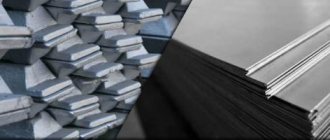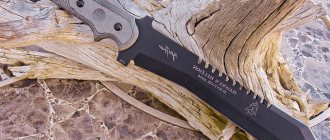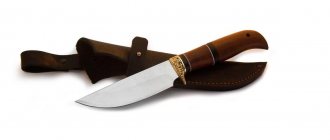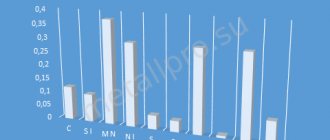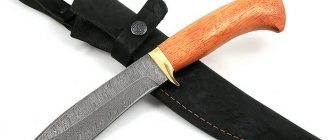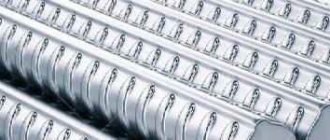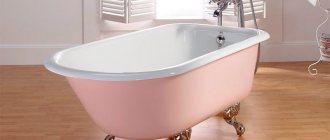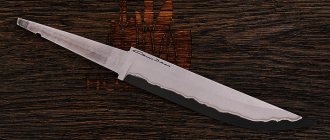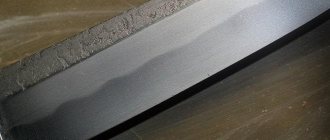If you are reading this article, then you are probably going to choose and buy a knife, but you want to study the theoretical part first, because the purchase is not on the budget.
Before you read the article, our promo code MHKNIFE gives an 8% discount on a knife over 30,000 rubles from our range! Simply enter the code in the “Discount Coupon” box when placing your order.
What do you think is the key parameter when choosing a knife? His appearance? Design? Or maybe the size? No. A knife starts with steel. The quality, functionality and durability of the future blade depends on it. It is she who determines its value. We have tried to briefly outline the main types of steels, their comparison and characteristics.
From a physicochemical point of view, steel is an alloy of iron and carbon, to which special alloying components are added. They allow you to give the metal the desired properties and, in essence, determine the type of steel. Its performance characteristics also depend on manufacturing processes, rolling and hardening.
Key material characteristics
- Hardness _ This parameter demonstrates the ability of a material not to deform under force or pressure. It is measured according to the Rockwell scale (HRC).
- Durability . This characteristic reflects the material’s resistance to chipping and cracking when used in difficult conditions. It also shows how much the blade can bend without becoming completely deformed.
- Corrosion resistance . A parameter characterizing the resistance of steel to rust, pitting and other corrosive damage caused by environmental influences.
- Wear resistance . A characteristic that determines the resistance of a material to adhesive and abrasive effects. It depends on the chemical composition of the steel and its hardness.
- Holding the cutting edge . An important parameter that determines how long the blade will remain sharp with regular use. There is no standardized way to measure this parameter. It is determined by the subjective feelings of users.
It is worth noting that the highest HRC value does not indicate high quality steel. This material will hold the cutting edge perfectly, but cracks and chips will appear on it quite quickly. Moreover, a blade that is too hard can break like glass. But steel that is too soft cannot be considered high quality - it will hardly cut most materials.
Strength has no standard school of measurement. It's also worth considering that harder steel will likely have lower strength, and vice versa.
Oddly enough, steel that is almost completely protected from corrosion reduces the overall performance of the blade. Therefore, the corrosion resistance of the working knife should be moderate.
When considering two blades with the same hardness value, the one with more carbides in its composition will be more wear-resistant.
It would seem that in order to buy the perfect knife, you need to choose a model whose blade has the maximum performance of all the characteristics described above. In practice, everything is more complicated, because if the hardness of the blade is maximum, then it will turn out to be very fragile and will not be able to withstand even minimal interaction with hard materials. If the strength is maximum, the blade will not hold an edge. Therefore, only a knife in which all of the specified parameters are balanced can be considered ideal.
Hunting knife parts
Regardless of the chosen steel grade and manufacturer, all hunting knives have components with common names:
- The blade is the cutting part of the tool.
- Shank - steel base for attaching the handle.
- The blade is a part of the blade with a sharp sharpening.
- The butt is the unsharpened part of the blade. Located on the back side of the blade.
- The point is the place where the butt meets the blade.
- The heel is the area at the base of the handle.
- Valleys are narrow grooves along the ribs. They are designed to give the blade rigidity. Another of their tasks is to reduce the weight of the blade.
- Handle - used to wrap your hand around when performing any actions with a knife.
Types of steels
Three types of steel are actively used in knife production today:
- instrumental _ It is used in the manufacture of cutting tools and is characterized by high hardness. Examples of tool steel are alloys D2, O1, CPM 3V and M4;
- carbonaceous _ This is a strong and durable material that is suitable for use in difficult conditions. Indispensable in the production of machetes, various knives for work and survival in difficult conditions. It is susceptible to corrosion, but is easy to sharpen and retains its sharpness for a long time. The most popular example of such steel is alloy 1095.
- stainless steel A type of carbon steel that contains at least 13% chromium and other additives that improve the performance properties of the material, but reduce its strength. Steels of this type include alloys Sandvik, VG, 400, SxxV, MoV, AUS, 154CM, CTS, etc.
Review of modern steels used in knife production
Budget steels
| Steel | Features of the composition | Characteristics | Application |
| 420 and 420J | Carbon content does not exceed 0.5%. | It has good oxidation resistance and fairly high strength. At the same time, it has low hardness, which has a bad effect on holding the cutting edge. | Mass production of kitchen knives and other tools sold at low prices. |
| AUS-6 | Low carbon content. | It has excellent anti-corrosion abilities. Quite soft. | Mass production of kitchen knives and other tools sold at low prices. |
| Steel | Features of the composition | Characteristics | Application |
| 420 and 420J | Carbon content does not exceed 0.5%. | It has good oxidation resistance and fairly high strength. At the same time, it has low hardness, which has a bad effect on holding the cutting edge. | Mass production of kitchen knives and other tools sold at low prices. |
| AUS-6 | Low carbon content. | It has excellent anti-corrosion abilities. Quite soft. | Mass production of kitchen knives and other tools sold at low prices. |
Mid-level steels
| Steel | Features of the composition | Characteristics | Application |
| 1095 | Contains about 1% carbon. | Holds the cutting edge well, is not afraid of corrosion, and is not susceptible to chipping. Can be sharpened to razor sharpness. | It is one of the most used steels due to its good performance and inexpensive production. Indispensable for the production of large knives with fixed blades used by tourists and other persons when performing heavy work. |
| 13C26 | The material is similar to 440A steel, but the percentage of chromium and carbon in it is slightly higher. | AEB-L version released by the Sandvik brand. Resistant to oxidation, quite hard. | The steel is designed specifically for razor blades. |
| 420HC | Increased carbon content. | Considered the best representative of the 420 series. Has high hardness. Due to high-quality heat treatment, it can demonstrate excellent anti-oxidation properties and confidently hold the cutting edge. | Since this steel is considered one of the best in terms of resistance to corrosion processes, it is used by many well-known manufacturers, for example, Buck. |
| 440A | Compared to 420CH, this material contains more carbon. | Hard steel that can hold a cutting edge for a long time. Afraid of corrosion. | Wide scope of application. |
Quality steels
- 14 C28 N is a stainless steel that is an improvement on 13C26 steel (corrosion resistance has been increased). In its composition, the amount of carbon was reduced and the proportion of chromium was increased, and nitrogen also appeared. The steel is produced by the Sandvik brand from Sweden and is distinguished by the ability to sharpen to a razor-like finish. The Kershaw brand is very fond of this steel.
- 8 Cr13 MoV . Chinese material, the characteristics of which are similar to those of AUS-8 steel. But steel from China contains more carbon. Valued for its balanced price-quality combination, it is actively used by Spyderco and other well-known brands.
- CTS- BD1 . Material developed by the American brand Carpenter specifically for Spyderco. Similar to AUS-8 and 8Cr13MoV materials, but superior to them in terms of cutting edge retention. Moreover, the steel in question, due to its high chromium content, better resists corrosion. It is easy to sharpen (it contains small carbides), although the sharpening time is inferior to materials with large carbides (for example, G-10).
- AUS-8 . Durable Japanese steel, similar in properties to 440C material. It differs from the latter in lower hardness and greater corrosion resistance. Effortlessly sharpens to a razor-sharp state, although it retains the cutting edge worse than its older comrades, which contain more chromium.
- 440 C. _ A universal material that has long been considered the leader among knife steels. It lost its position only with the advent of super steels. Today it is used to produce tools of average cost, characterized by exceptional corrosion resistance (contains the maximum carbon and chromium among steels in this subgroup), fairly high wear resistance and hardness. It keeps the cutting edge sharp better than 420HC steel, and is no less easy to sharpen.
High quality steel
| Steel | Features of the composition | Characteristics | Application |
| N680 | 17% chromium; 0.2% nitrogen | Excellent anti-corrosion capabilities. Easy to sharpen. Holds the cutting edge well. It is considered an affordable modification of the H1, but in terms of edge preservation it is significantly inferior to the ATS-34 and 154CM. | Suitable for knives and other products that are often exposed to salt water. |
| H1 | High content of anti-corrosion components. | Excellent corrosion resistance and almost no rust. But it doesn't hold the edge very well. | This type of steel makes the best knives for diving. But for EDC it is better to use a different material. |
| VG-10 | Contains strength-increasing vanadium. It exceeds steel 154CM and ATS-34 in chromium content. | It features high levels of anti-corrosion resistance and strength. Has sufficient strength. It retains the sharpness of the blade quite well, but there is a risk of chipping since the steel is brittle. Overall, a good, and most importantly, time-tested option. | It is actively used by the Spyderco brand and other companies operating in a similar price segment. |
| D2 | It is called “semi-stainless” because it contains less chromium than analogues, but still resists corrosion well. | It surpasses steel 154CM and ATS-34 in hardness and holds an edge well. In terms of strength, it is confidently “average” and does not sharpen well. | Suitable for the production of high-quality and not too expensive knives. |
| 154CM | Contains molybdenum. The amount of chromium is significantly less than that of 440C steel. | It is considered an improved version of the 440C material. It has equally outstanding resistance to oxidation and is distinguished by decent strength. Holds the edge perfectly. Excellent sharpening using abrasives. | Widely used by leading manufacturers, including Benchmade. |
| ATS-34 | The composition is similar to material 154CM. | Japanese equivalent 154CM. Characterized by high quality. Compared to 440C, it has a greater tendency to corrosion, but holds the edge better. | A popular steel among many knifemakers. |
Premium steel
| Steel | Features of the composition | Characteristics | Application |
| CPM S30V | Contains vanadium carbides and niobium. | It is not afraid of corrosion and holds the edge perfectly. Has a very hard alloy matrix. Thanks to niobium, it is easy to process. The balance of hardness and strength is almost perfect. | American manufacturers love to use this steel to produce professional kitchen utensils and various models of pocket knives. |
| CPM S35VN | It has a fine-grained structure. Contains niobium. | This steel is an improved variation of the incredibly popular S30V material. It is distinguished by exceptional strength and easy sharpening, oxidation resistance and the ability to confidently hold an edge. | It is used as widely as S30V steel. It is considered an example of super steels. |
| CPM M4 | High content of molybdenum, tungsten, carbon and vanadium. Little chrome. | High performance carbon material exhibiting superior edge holding ability. It is characterized by high strength, wear resistance and amenability to processing. Due to the small amount of chromium in the composition, it is afraid of corrosion. Difficult to sharpen. | A good option for those cases when the knife must be durable and wear-resistant at the same time. |
Ultra premium steel
- CTS- XHP is a material from an American brand that appeared on the market not so long ago. It has a hardness of 61 HRC and the ability to hold an edge confidently - better than S30V material. This steel is produced from powder with very fine grains. In many ways it is similar to D2 material, but it resists corrosion much more effectively. Sharpening requires some effort.
- Elmax . Another powder steel, which contains a high content of molybdenum, chromium and vanadium. It is not afraid of oxidizing substances, is characterized by exceptional wear resistance and long-term edge retention. Steel belongs to the class of stainless steel, but its properties are in many ways similar to carbon materials. Sharpening is relatively easy. Elmax is rightfully considered one of the best steels in the world. It is used by many premium manufacturers, including Bohler.
- ZDP-189 is a Hitachi steel with a very high percentage of chromium and carbon in the alloy. Its hardness reaches 64 HRC, as a result, the cutting edge is held perfectly. But sharpening requires considerable effort, as does corrosion protection - the resistance of this material to oxidative processes is significantly lower than that of S30V.
- M390 is a third generation steel containing tungsten, molybdenum, vanadium and chromium. It holds the edge confidently and resists corrosion, is wear-resistant and hard. After heat treatment, the last parameter can reach a value of 60-62 HRC.
- CPM S90 V is an expensive material with a high carbon content. Also includes vanadium, which is three times more than S30V and Elmax. The steel is incredibly resistant to abrasions and wear, and holds the cutting edge perfectly. But it is not easy to machine it, just like other steels of this class.
Composition and additives
Pieces of high carbon 1095 steel and 15n20 steel with a lot of nickel.
Steel is an alloy of iron and carbon. The rigidity of the material depends on the last element.
The following types of steel are distinguished:
- low carbon;
- medium carbon;
- high carbon.
Knives made of unalloyed steel (without additives) are flexible, but are susceptible to corrosion and are not resistant to damage. To improve the characteristics of the metal, impurities are added to the alloy. The table provides a list of additives used (brief explanations of their functions).
| Element | Functions |
| Manganese (Mn) | Provides strength, allows you to make any blade shape. Present in most steel alloys. |
| Molybdenum (Mo) | Allows you to harden steel to a high level of hardness, makes the blade heat-resistant, and reduces the fragility of the blade. |
| Chromium (Cr) | Protects against the effects of rust. |
| Vanadium (V) | Responsible for resistance to chemicals and increases elasticity. Increases the service life of the product. |
| Silicon (Si) | Reduces the material's susceptibility to mechanical stress, increasing strength. |
| Nickel (Ni) | Prevents steel from rotting and increases corrosion resistance. |
| Tungsten (W) | Increases strength and enhances anti-corrosion properties. |
Sulfur and phosphorus are considered technological impurities. The first element reduces the hardness and strength of the metal; in high-quality alloys the percentage does not exceed 0.065. Phosphorus increases the brittleness of steel. This element is present in all alloys, but the maximum level of the substance in the alloy is 0.045%.
A few words about powder steel
In the descriptions above, you probably noticed the abbreviation CPM in the names of some steels. This abbreviation can be translated into Russian as Crucible powder metallurgy. Crucible is the name of an American brand that produces tool steels of exceptional quality.
The company uses a special technology, as a result of which molten steel is processed into fine powder. It is pressed into forms prepared in advance, in which it is subsequently baked. It is easy to introduce various additives into such powder, which makes it possible to produce steel with certain operational parameters.
Sharpening knives
Over time, even the highest quality steel becomes dull. In this regard, the blade needs periodic sharpening. The approach to this operation is largely determined by the shape of the blade. It is most convenient to work with a shape in the form of a double wedge with uniform bevels of the blade on both sides. This type of knife is suitable for any operation and is the easiest to sharpen.
When performing work, it is important to maintain the original sharpening angle. The smaller it is, the more filigree work can be done with a knife. For delicate operations, blades sharpened at 9–16 degrees are suitable. A 20-degree sharpening is considered universal. For rough operations you will need an angle of up to 30 degrees.
Sharpening is carried out using a sharpening stone with a not very rough surface. Typically, 20-centimeter flat and wide stones are used for this. Before starting work, they are moistened with oil (vegetable or even technical oil will do). If there is no oil, you can use a soap solution.
The blade is positioned at the required angle. Next, with decent pressure, they begin to move the knife towards themselves on the stone. 5-6 movements are enough, after which the blade is turned over and the same amount of friction is performed on the stone again.
A shiny stripe will appear along the entire length of the metal being sharpened. It should be the same width across the entire blade. If the blade is not sharp enough the first time, the work is repeated. However, this time they put in a little less effort. For the second sharpening, it is recommended to use a stone with a fine-grained structure.
The final operation is to correct minor defects in the metal surface and polish the pointed area. A properly sharpened blade of a hunting knife should cut a sheet of newspaper without any effort.
Special devices are used to sharpen difficult-to-grind blades. On a horizontal board, ceramic sharpening sticks are installed in the holes provided for this purpose. With their help, you set the desired sharpening direction. Blade movements go from top to bottom.
Let's sum it up
As you can see, perfect steel does not exist. But for each task there is its own optimal version of the metal alloy. This is the one that should be chosen. We also advise you to pay attention to other characteristics of the finished product: its design, construction, workmanship, etc. After all, in fact, all modern knife steels fully satisfy the needs of the average user. The difference is noticeable only to professionals.
This article covers the topic at hand, however, if you still have additional questions, please contact us for advice and help with your choice by phone or leave a request on the website.
Recommendations for use
To ensure that a kitchen knife with a steel blade lasts a long time, follow simple rules of operation and care:
- Do not heat the blade - high temperatures will dull the cutting edge.
- Do not leave the blade dirty or wet - always wash and dry with a paper towel or non-woven cloth to remove lint.
- Store knives separately from other utensils, preferably vertically in a special stand. A modern solution is a stand with a filler, the choice of which we have already talked about. When stored this way, the blades are securely isolated from each other.
- If rust appears, do not rush to look for chemicals; try wiping the stain with a microfiber cloth.
It is possible to advise what steel to buy a knife from only after identifying the tasks that will be assigned to it. If this is a butter knife, then there is no point in looking for the hardest and most durable brand, since the load in this case is minimal.
Another thing is the choice of a tool for cutting meat; here you need increased hardness and sharpness. You shouldn’t save money when buying chef’s three-piece kitchen knives, because they are used in the kitchen every day, which means the blade runs the risk of becoming dull.
